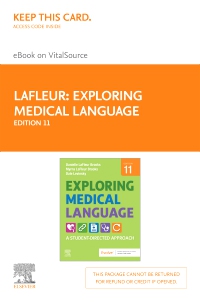
Exploring Medical Language Elsevier eBook on VitalSource (Retail Access Card), 11th Edition
Elsevier eBook on VitalSource - Access Card

Let students master medical terms on their terms! A combination text/workbook, Exploring Medical Language, 11th Edition provides exercises that make it easy to build an understanding of medical terminology. Organized by body system, medical terms are divided into two categories: 1) Words built from word parts, and 2) Words NOT built from word parts. Fun and engaging exercises help students first learn word parts and then learn how to combine the parts into full medical terms that make sense. The text also comes packaged with paper flashcards. For more practice, an accessible Evolve website offers games, activities, flashcards, and practice exams. An innovative teaching/learning package, this worktext helps students gain fluency in medical language and communicate clearly in the health care setting.
-
- NEW! Organization of word part tables in each chapter allows the instructor to teach body systems in any order
- NEW! Clinical note-taking exercises teach students how to convert common symptoms into correct medical terminology
- Comprehensive coverage of medical terminology creates a distinction between terms built from word parts, which are usually based on Greek or Latin, and those terms NOT built from word parts, which are based on eponyms, acronyms, or terms from modern language
- Systematic presentation provides a foundation of word parts (prefix, suffix, word root, and combining vowel), then builds words by combining the parts
- Case studies ask students to interpret medical terms used in medical records and to translate everyday language into medical language
- Full-color illustrations encourage students to apply the meaning of word parts by labeling anatomical figures
- Abbreviations tables introduce abbreviated medical terms related to chapter content, and are supplemented with exercises, flashcards, and practice quizzes
- Reviews of word parts and terms provide students the practice they absolutely need to define, pronounce, and spell medical terminology
- More than 400 flashcards enable students to review word parts whenever and wherever they want
- Interactive exercises and games on the Evolve website provide endless opportunities to practice building, hearing, and spelling terms
- Medical Terminology Online (MTO) provides accessible, interactive exercises and supplementary content in a course companion to help students master the medical terminology presented in the text. With Elsevier Adaptive Learning accessible within the modules, MTO allows students to learn faster by delivering content precisely when it’s needed, and it constantly tracks student performance! Available separately
- NEW! Elsevier Adaptive Quizzing (EAQ) is now available for separate purchase–Elsevier Adaptive Quizzing is a highly effective, formative evaluation tool that strengthens students' knowledge and confidence with high-quality practice questions. Through personalized quizzing, students and instructors can identify weak topic areas and develop simple strategies to improve their results
-
- NEW! Organization of word part tables in each chapter allows you to learn body systems in any order.
- NEW! Clinical note-taking exercises provide practice with how to convert common symptoms into correct medical terminology.
-
1. Introduction to Medical Language
2. Body Structure, Oncology, and Laboratory Tests
3. Directional Terms, Positions, and Imaging
4. Integumentary System
5. Respiratory System
6. Urinary System
7. Male Reproductive System
8. Female Reproductive System
9. Obstetrics and Neonatology
10. Cardiovascular, Immune, Lymphatic Systems and Blood
11. Digestive System
12. Eye
13. Ear
14. Musculoskeletal System
15. Nervous System and Behavioral Health
16. Endocrine System
Appendix
A: Answer Keys
B: Combining Forms, Prefixes, and Suffixes Alphabetized by Word Part
C: Combining Forms, Prefixes, and Suffixes Alphabetized by Definition
E: Pharmacology Terms
On Evolve:
F: Additional Combining Forms, Prefixes, and Suffixes
G: Health Care Delivery Terms
H: Integrative Medicine Terms
I: Behavioral Health Terms
J: Clinical Research Terms
K: Nutrition Terms
L: Dental Terms
M: Health Information Technology (HIT) Terms




 as described in our
as described in our 